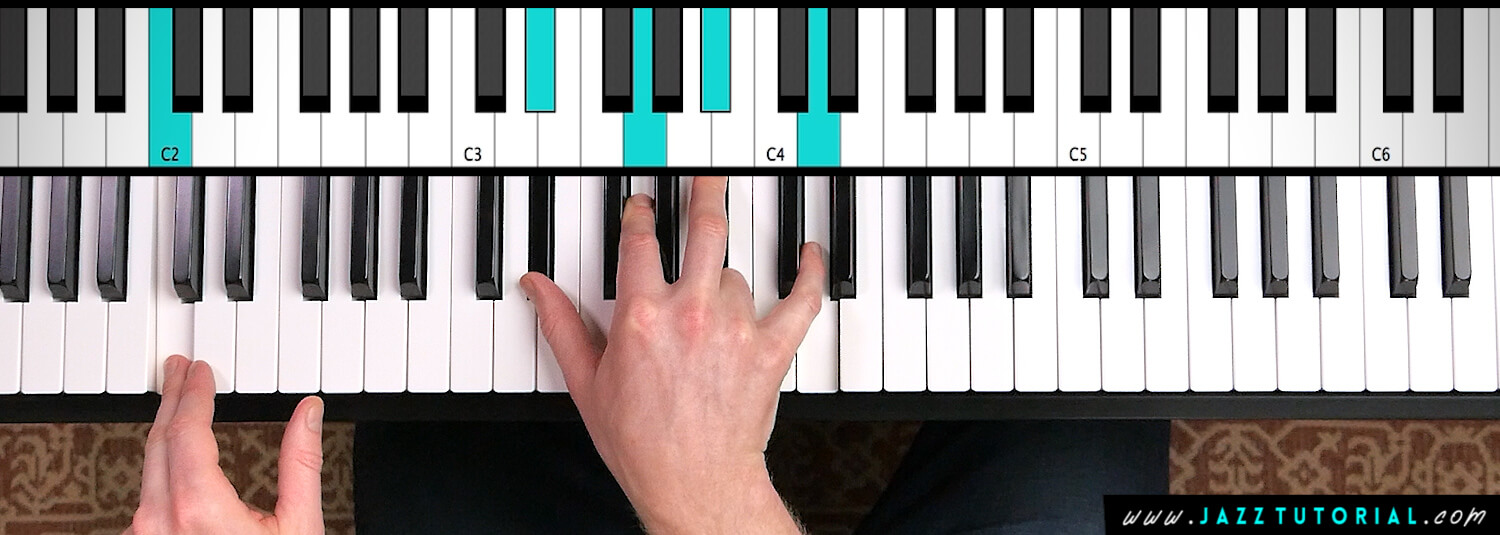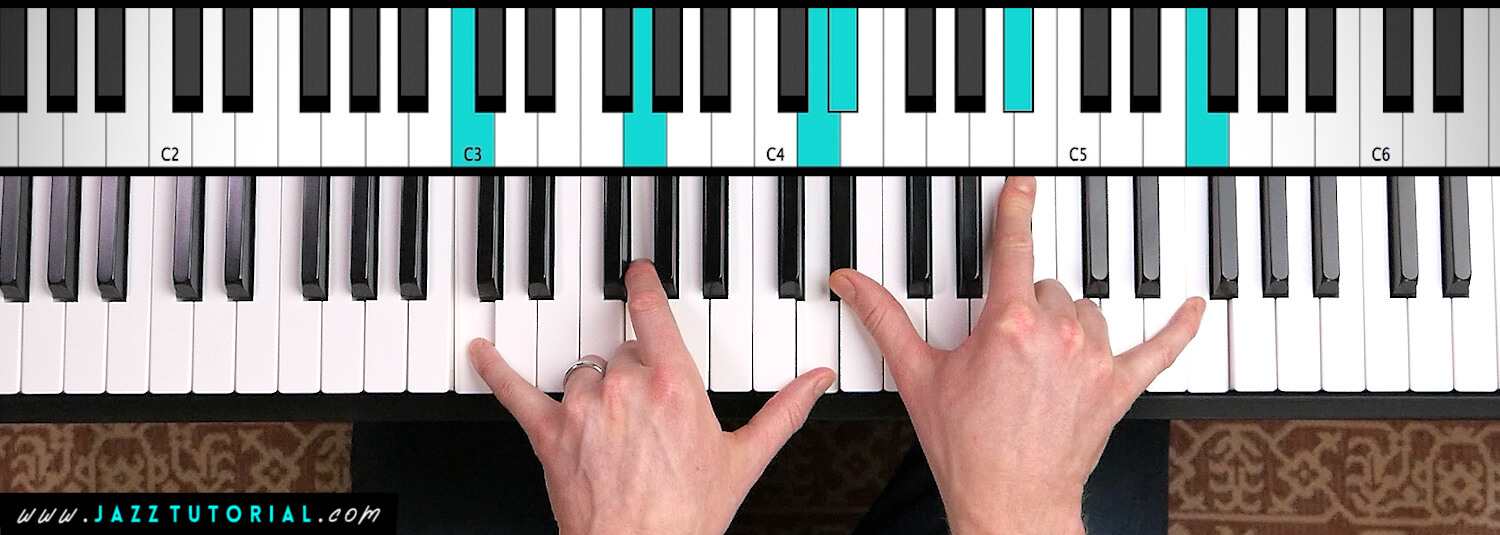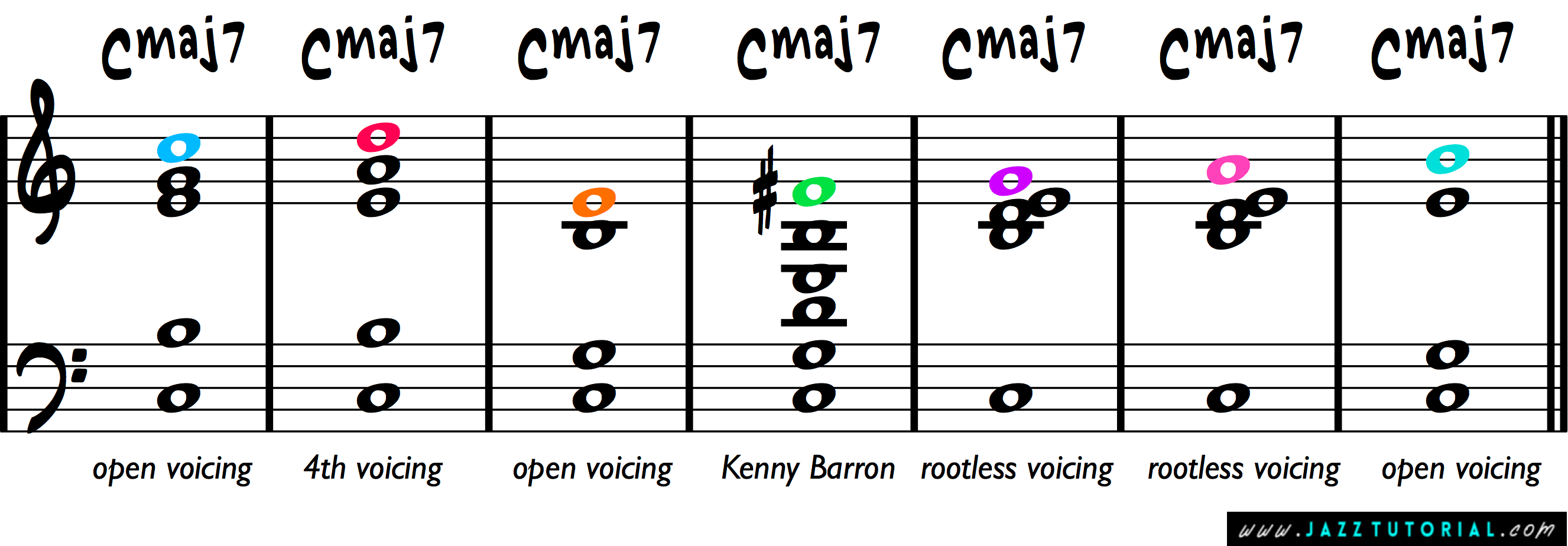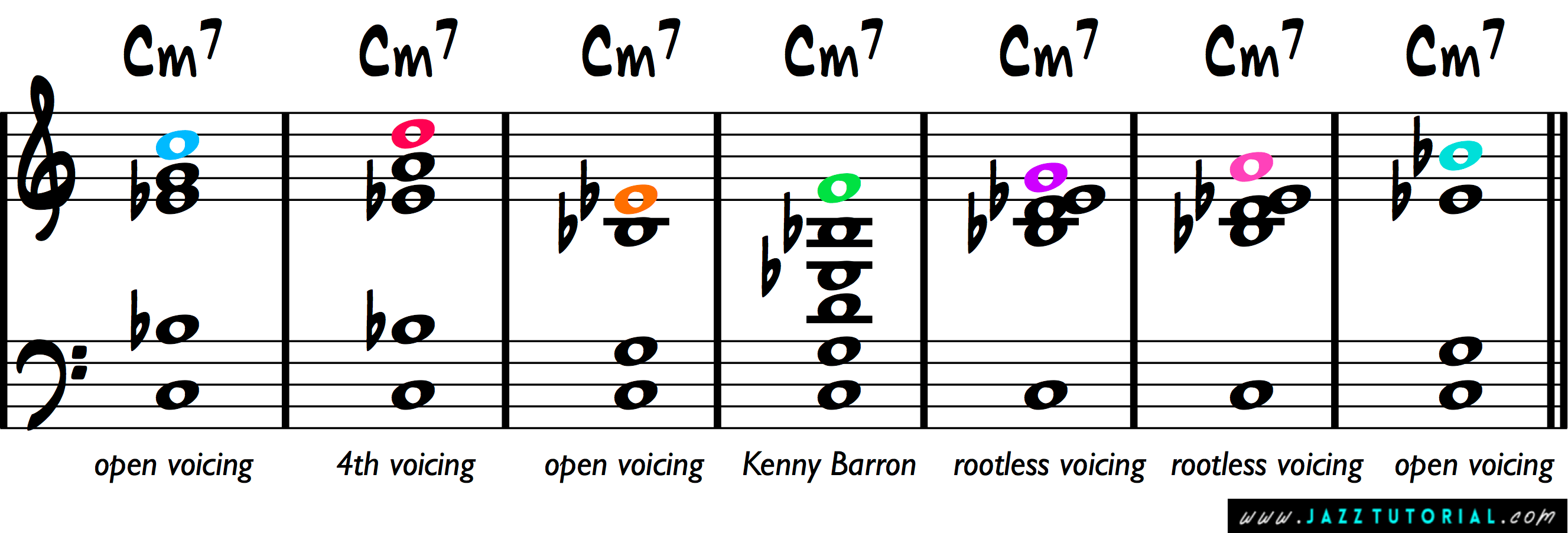The Jazz Piano Chord Voicing Guide: How to Choose Which Voicings to Play
There are literally dozens of chord voicings you could play for any chord in jazz...
Take a look at some of the different ways I could voice C major 7 alone:

So how do you decide which chord voicing to use?
In this article I'll show you the simple method I use to choose my voicings. It's called 'melody-matching'...
Melody-Matching Explained
When playing through a jazz song from my real book, I look for two things:
First of all, what type of chord is it? Is it a major 7 chord, minor 7, V7, ø, º7?

And secondly, what's the melody note in relation to the chord? i..e. what scale degree is the melody note in relation to the chord - is it the 9th, 5th, 11th, root, etc?
Once I’ve looked at these two things, I then scan my ‘memory bank’ of chord voicings to find a voicing for that type of chord (major 7, minor 7, etc) which already has the melody note as its top note.
So for example, if the chord symbol says ‘C minor 7’, and the melody note is D - my first step is to figure out which scale degree D is in relation to C minor 7. Do you know the answer?
Well D is the 9th of C - so I need to find a chord voicing for C minor 7 which has the 9th as its top note - like this:

By playing the chord voicing above (a 'rootless voicing' for C minor 7), I end up playing the chord (C minor 7) and the melody note (the 9th) together.
Or let’s say the chord symbol says ‘C minor 7’, and the melody note is F - my first step is to figure out which scale degree F is in relation to C minor 7. Do you know the answer?
Well F is the 4th (or 11th) of C - so I want to find a chord voicing for C minor 7 which has the 11th as its top note - like this:

By playing the chord voicing above (a 'Kenny Barron voicing' for C minor 11), I end up playing the chord (C minor 7) and the melody note (the 11th) together.
I call this technique ‘melody-matching’ - because you are 'matching' your chord voicing to the melody note. When you use melody-matching, you’ll naturally find yourself varying your chord voicings throughout the song - some rootless voicings, some shell voicings, some 4th voicings, some upper structures, and so on:

It's nice because you don’t have to come up with a complicated plan for how and why you’re choosing each voicing. Instead, simply look at the melody note and choose a voicing that has that note at the top.
FREE RESOURCE: For a complete set of jazz piano chord voicings, you can download my free ‘Jazz Piano Chord Voicing Guide' which shows you 5 types of chord voicing used by professionals (shells, 4th voicings, rootless voicings, and more): Click here to download
“How many voicings do I need to know?”
For ‘melody matching’ to work, you’ll need to know quite a few chord voicings to choose from...
In fact, you’ll need to know at least one chord voicing for every possible melody note that could be at the top: root, 2nd, 3rd, 4th, 5th, 6th and 7th.
That means you’ll need to know seven chord voicings for major 7 chords - in order to be fully prepared:

Then you would need seven chord voicings for minor 7 chords - each with a different melody note at the top:

In addition, you’ll need to know a few more voicings for dominant 7 chords (roughly 10 V7 voicings), since it’s common for melodies to play altered chord extensions over V7 chords - like the b9, #9, #11, b13 - in addition to the 7 natural scale degrees (1 2 3 4 5 6 7).
Those are the three types of 7th chord which make up 80% of jazz - major 7, minor 7, and V7.
KEY POINT: So in total, you’ll need to know about 24 chord voicings (7 major, + 7 minor, + 10 dominant), in order to voice most jazz songs.
If you don’t know this many chord voicings yet, you can download my Jazz Piano Chord Voicing Guide (free)which shows you a complete set of chord voicings - including 'shells', rootless voicings, 4th voicings, open voicings, and more.
"What if I only know a few voicings?"
If you don’t know many chord voicings yet - then don't worry...
First, know that you can always fall back on playing ‘literal voicings’ (my term for playing literally what the chord symbol says - 1 3 5 7). For every chord that you don’t have a flashy voicing for, just play the literal chord in your left hand (1 3 5 7, or in 2nd inversion: 5 7 1 3), and the melody in your right hand:

Then, on top of this basic background, you can start to 'pepper in' a few advanced chord voicings using the 'melody-matching' technique - whenever you spot a chord / melody note for which you know an appropriate chord voicing.
"Which voicings should I learn first?"
I recommend learning the following types of chord voicing first:
-
Literal voicings (1 3 5 7 of any chord).
-
Rootless voicings for major 7 and minor 7 chords only (3 5 7 9 and 7 9 3 5).
-
Upper structures for V7 chords. Learn more about Upper Structures here.
Using just these three types of ‘sophisticated chord voicings’ - in combination with the ‘literal voicings + melody’ texture will give you great-sounding results right away.
Homework Challenge
Play through the songs in your real book using the simple 'chord + melody' texture discussed above. While doing this, look out for opportunities to 'pepper in' any sophisticated chord voicings you already know.

Free Sheet Music
Can I send you 39 pages of Jazz Piano sheet music?
-
Includes '29 Jazz Licks' (sheet music)
-
'The Chord Voicing Guide' (ebook)
-
'Sweet Chord Progressions and Riffs' (sheet music)
About the Author
Julian Bradley is a Jazz pianist and music educator from the U.K. He has a masters degree in music composition and loves helping musicians learn Jazz piano and reach their music goals. YouTube channel.
